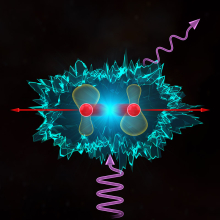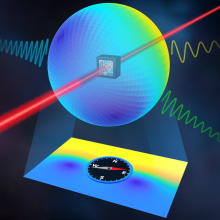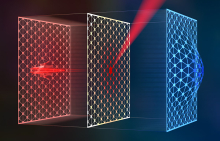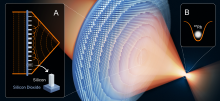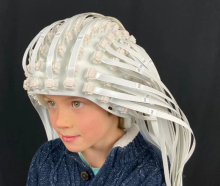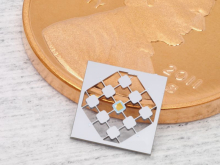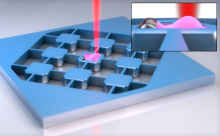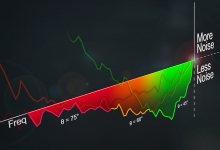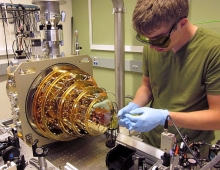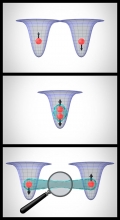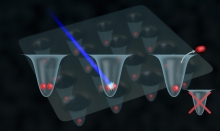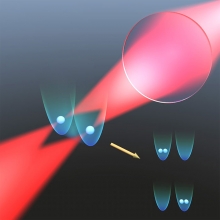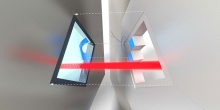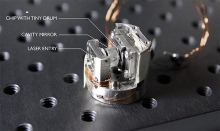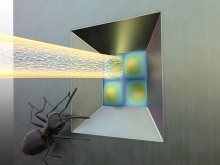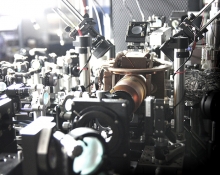Research Highlights
Quantum Billiard Balls: Digging Deeper into Light-Assisted Atomic Collisions
Published:
PI: Cindy Regal | PI: Jose D'Incao
Topics: Atomic & Molecular Physics | Topics: Laser Physics | Topics: Quantum Information Science & Technology
Tracking Magnetic Field Directions Using Tiny Atomic Compasses
Published:
PI: Cindy Regal
Topics: Laser Physics | Topics: Precision Measurement | Topics: Quantum Information Science & Technology
A Drum Sounding Both Hot and Cold
Published:
PI: Cindy Regal
Topics: Laser Physics | Topics: Precision Measurement | Topics: Quantum Information Science & Technology
A Quantum Video Reel
Published:
PI: Cindy Regal | PI: Ana Maria Rey
Topics: Precision Measurement | Topics: Quantum Information Science & Technology
JILA and NIST Researchers Develop Miniature Lens for Trapping Atoms
Published:
PI: Cindy Regal
Topics: Atomic & Molecular Physics | Topics: Precision Measurement | Topics: Quantum Information Science & Technology
A Look at Colorado's Quantum Revolution
Published:
PI: Jun Ye | PI: Cindy Regal | PI: Margaret Murnane | PI: Henry Kapteyn | PI: Ana Maria Rey
Topics: Quantum Information Science & Technology
Connecting Microwave and Optical Frequencies through the Ground State of a Micromechanical Object
Published:
PI: Cindy Regal | PI: Konrad Lehnert
Topics: Precision Measurement | Topics: Quantum Information Science & Technology
New Research Reveals A More Robust Qubit System, even with a Stronger Laser Light
Published:
PI: Cindy Regal | PI: Konrad Lehnert
Topics: Precision Measurement | Topics: Quantum Information Science & Technology
Where Science Meets Art: A Mural on AMO Physics
Published:
PI: Cindy Regal
Topics: Atomic & Molecular Physics | Topics: Physics Education
Optical tweezers achieve new feats of capturing atoms
Published:
PI: Cindy Regal
Topics: Atomic & Molecular Physics
Quiet Drumming: Reducing Noise for the Quantum Internet
Published:
PI: Cindy Regal | PI: Graeme Smith | PI: Konrad Lehnert
Topics: Quantum Information Science & Technology
The Chameleon Interferometer
Published:
PI: Cindy Regal | PI: Konrad Lehnert
Topics: Precision Measurement
How Cold Can a Tiny Drum Get?
Published:
PI: Cindy Regal | PI: Konrad Lehnert
Topics: Nanoscience | Topics: Precision Measurement | Topics: Quantum Information Science & Technology
Natural Born Entanglers
Published:
PI: Ana Maria Rey | PI: Cindy Regal
Topics: Atomic & Molecular Physics | Topics: Quantum Information Science & Technology
An Array of Possibilities
Published:
PI: Cindy Regal
Topics: Quantum Information Science & Technology
The Little Shop of Atoms
Published:
PI: Cindy Regal
Topics: Atomic & Molecular Physics | Topics: Precision Measurement
Good Vibrations: The Experiment
Published:
PI: Cindy Regal | PI: Konrad Lehnert
Topics: Quantum Information Science & Technology
The Squeeze Machine
Published:
PI: Cindy Regal
Topics: Atomic & Molecular Physics | Topics: Precision Measurement
Position Wanted
Published:
PI: Cindy Regal
Topics: Precision Measurement | Topics: Quantum Information Science & Technology





